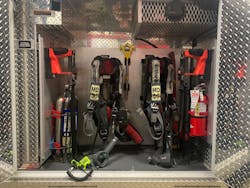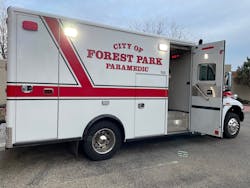It’s a scenario that plays out thousands of times per day: a tiered EMS response by fire-based EMS systems. The mission is to get highly cross-trained firefighter/paramedics on scene in apparatus that doesn’t inhibit their efficiency and effectiveness while they operate at emergency incidents.
Fire departments that provide transport EMS services have several critical specification points that must be considered during the apparatus needs analysis. These include chassis requirements, body configuration and patient-care compartment layout.
When you begin your apparatus needs analysis, familiarize yourself with two national standards: NFPA 1917: Standard for Automotive Ambulances and KKK-A-1822: Federal Specification for the Star-of-Life Ambulance. They provide invaluable insight into the specification process.
Chassis
Key to selecting a chassis is the gross vehicle weight rating (GVWR) and how the box attaches to the chassis. According to KKK-A-1822, “chassis for medic units come in a variety of types: Type I—cab chassis with a modular body; Type II—van style chassis with integrated cab-body; Type III—cutaway van style chassis with a modular built box.” Both Type I and Type II have additional duty subtypes, which increase the GVWR to 14,001 lbs. or more. The chassis must match an organization’s preventative maintenance schedule as well as its expected life cycle.Body configuration
The configuration of the interior and exterior of the box and body depends on an organization’s equipment requirements for both fixed and portable equipment. An additional requirement that separates fire-based EMS medic units from third-party EMS providers is the need to carry firefighting PPE, including SCBA, and associated hand tools.
Several considerations must be taken into account when laying out exterior body compartments. The onboard oxygen compartment must be designed for either a single “H” or dual “M” cylinders. The main advantage of dual “M” cylinders is the ability to rotate between cylinders. Another advantage is their lighter weight when switching them out compared with a standard “H” cylinder.
Any electric lift also should be considered, particularly when steel “H” cylinders are used.
Lastly, a pass-through should be provided to the patient compartment to manually turn cylinders on and off if the need arises.
Compartments
Firefighting PPE, including SCBA, generally is carried in street-side compartments to facilitate donning and doffing of the gear. An available option is to move the PPE and SCBA compartment to the curbside of the vehicle to make donning and doffing the gear safer when operating in the roadway. Many medium-duty chassis offer extended cab compartments to facilitate firefighting equipment on both sides of the unit. Regardless of the layout, this can take a considerable amount of space.
Charging considerations for light boxes also must be considered.
In addition to firefighting PPE, hand tools, including a hydrant wrench, a set of irons and a hook, and water also can have separate storage requirements.
This all depends on a department’s policies regarding medic crews that turn out at fire incidents.The remainder of the exterior storage compartments is based on an organization’s portable equipment requirements and its need for the equipment to be rapidly accessible.
Of course, ensuring pass-through compartments allows for equipment to be accessed from both the interior and exterior of the unit. This is particularly important in regard to first-in bags and splints, which can be invaluable for critical patients.
One last consideration: positioning of the curbside patient compartment door. Moving the patient compartment door forward to the front right of the box affords patient privacy when the door is open at an incident scene.
Lastly, for a minimal charge, most manufacturers provide electrically “fogged” windows on the side and rear doors to increase patient privacy.
Patient compartment
Decisions regarding the interior patient compartment are critical to ensure efficiency and crew safety when working on patients. The main goal of designing the patient compartment is to keep personnel in the seated position with a fastened seatbelt or seat harness attached. This requires all critical equipment to be within reach of the seated positions. You must ensure proper mounting and accessible location of, for example, cardiac monitors, computers and cellphones.
The positioning of the cot and any associated loading system also is important. Access of 360 degrees around the cot is preferable, particularly for the treatment of critical patients who require providers to work in tandem. Seating is designed around the cot’s location. You want to avoid seating that’s so high on the patient that a provider must come out of the seat to look for IV access on either side.
Smart positioning of the forward captain’s chair is important for airway management. The chair can be positioned along the curbside wall or centered on the cot.
Intelligent location of oxygen ports and charging outlets increases the efficiency of personnel. Specifying ports on both sidewalls and on the ceiling above the cot keep personnel in their restraint device. Furthermore, dual ports at this location can aid in CPAT and ventilator connections without having to remove the standard oxygen tree. Charging outlets can be USB, 12-volt or standard 120-volt. These are vital for charging portable equipment whether on shoreline power or while the unit is mobile.
The importance of interior lighting for both daytime and nighttime operations often is overlooked. For example, work lights in action areas allow providers to shut the main overhead lights during transport when not needed, and adding several red work lights for nighttime transports is advisable, so as not to blind the patient.
All of the aforementioned lights should have the capability to be dimmed.
Lighting that’s connected to the patient compartment doors is advisable, so attendants don’t need to climb inside of the unit to get lighting when retrieving equipment. Switch locations should be accessible from both sides of the patient without having to undo personnel restraint devices.
And then there’s more
As with fire apparatus, it’s vital for the apparatus purchasing committee (APC) to consider the personnel who routinely will be assigned to a unit: The above considerations aren’t all-inclusive.
A special thanks to my organization’s medic unit APC member firefighter/paramedic Brad Crothers for assisting with this article.
Emergency and Scene Lighting
Emergency and scene lighting on fire-based EMS medic units must be laid out in a fashion that provides adequate lighting around all four sides of the vehicle. As with fire apparatus, NFPA 1917: Standard for Automotive Ambulances and KKK-A-1822: Federal Specification for the Star-of-Life Ambulance are rather specific in setting minimum standards for emergency lighting.
Forward-facing front scene lighting often is overlooked; many organizations rely on the vehicle’s headlights. Brow lights’ much higher mounting offers far superior forward lighting than headlights provide. Rear and right-side scene lights can be wired to the doors to provide lighting when loading the patient or entering the patient compartment from the street-side.
About the Author

Mark Miller
Mark Miller is a 26-year veteran of the fire service and currently is a deputy fire chief in Southwest Ohio. He holds a master’s degree in public safety administration, the Executive Fire Officer designation from the National Fire Academy and the Chief Fire Officer designation through the Center for Public Safety Excellence. Miller routinely speaks on fire apparatus positioning on the fireground and conducting an apparatus needs analysis.


